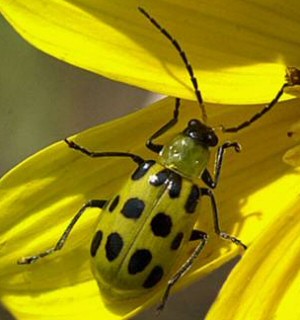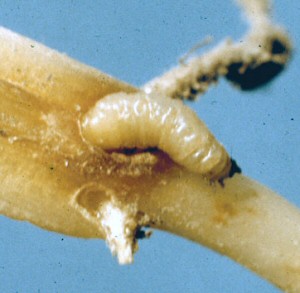Southern Corn Rootworm or Spotted Cucumber Beetle
 Scientific Name
Scientific Name
Diabrotica undecimpunctata
Host
Cucurbits and corn are preferred hosts, but the spotted cucumber beetle is known to feed on over 100 different plants. These include most vegetables and field crops, many flowers, weeds, and grasses. The larvae develop on the roots of a wide variety of plants.
Symptoms
Damage to cucurbits is similar to that of the striped cucumber beetle. The adults feed on stems and cotyledons of seedlings and foliage, flowers, and fruit of older plants. They also spread bacterial wilt and squash mosaic virus. Larvae feed on the roots and weaken plants. Damage to com is caused mostly by the larvae. They bore into the stalk just above the roots and kill the growing point of young plants. They also feed on the roots, which can cause lodging and yield reduction. Damage is more likely in cool, wet springs, in low, wet areas and where corn has followed corn for several years. Adults are sometimes common enough to interfere with pollination by feeding on the silks.
Life Cycle
 This insect overwinters in the adult stage in protected locations. They may be active
during the winter any time the temperature is over 65 F. Mating occurs in the early
spring, and each female will lay 500 or more eggs in cracks in the soil. Larvae feed
on plant roots for 2 to 4 weeks before pupating in earthen cells about one inch below
the soil surface. There are 2 or 3 generations per year and adults are active at least
into November.
This insect overwinters in the adult stage in protected locations. They may be active
during the winter any time the temperature is over 65 F. Mating occurs in the early
spring, and each female will lay 500 or more eggs in cracks in the soil. Larvae feed
on plant roots for 2 to 4 weeks before pupating in earthen cells about one inch below
the soil surface. There are 2 or 3 generations per year and adults are active at least
into November.
Description
The adult is oblong-oval in shape, bright yellowish green in color, and about 1/4 inch long. The head, legs, and antennae are black. The wing covers are marked with 12 black spots. The larvae are slender and yellowish white. The head and a plate at the rear of the body are brown. There are two short, sharp projections on the anal plate.
Control
Please contact your local county extension office for current information.
